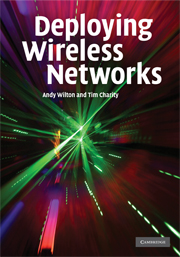Book contents
- Frontmatter
- Contents
- Foreword by Sir David Brown, FREng
- Preface
- Acknowledgements
- Authors' disclaimer
- 1 Introduction
- 2 Wireless network systems
- 3 Principles of access network planning
- 4 Introduction to RAN planning and design
- 5 GSM RAN planning and design
- 6 UMTS RAN planning and design
- 7 Cellular OFDM RAN planning and design
- 8 Mesh network planning and design
- 9 Core network and transmission
- 10 Network operation and optimisation
- Acronyms
- Index
- References
9 - Core network and transmission
Published online by Cambridge University Press: 13 August 2009
- Frontmatter
- Contents
- Foreword by Sir David Brown, FREng
- Preface
- Acknowledgements
- Authors' disclaimer
- 1 Introduction
- 2 Wireless network systems
- 3 Principles of access network planning
- 4 Introduction to RAN planning and design
- 5 GSM RAN planning and design
- 6 UMTS RAN planning and design
- 7 Cellular OFDM RAN planning and design
- 8 Mesh network planning and design
- 9 Core network and transmission
- 10 Network operation and optimisation
- Acronyms
- Index
- References
Summary
This chapter aims to provide an overview of the role of the core network and transmission in wireless solutions. Insight is given into the factors that have influenced network evolution from early cellular architectures, such as GSM Release 98, through to systems currently being standardised for the future, exemplified by Release 8. The chapter will conclude with a worked example illustrating the dimensioning of an IP multimedia system (IMS) transmission for a system supporting multiple applications.
It is useful to establish a common terminology before discussing networks in more detail. In the early 1990s, ETSI proposed the convention shown in Figure 9.1 [1], to distinguish between two distinct types of circuit service that a network might provide, namely bearer services and end-to-end applications, which it called teleservices. In the case of bearer services, a wireless network is ‘providing the capability to transmit signals between two access points’. Support of teleservices, however, requires the provision of ‘the complete capability, including terminal equipment functions, for communication between users according to protocols established by agreement between network operators’. Defining teleservices in this way has standardised the details of the complete set of services, applications and supplementary services that they provide. As a consequence, substantial effort is often required to introduce new services or simply to modify the existing one (customisation). This makes it more difficult for operators to differentiate their services.
Information
- Type
- Chapter
- Information
- Deploying Wireless Networks , pp. 274 - 299Publisher: Cambridge University PressPrint publication year: 2008
